Abstract
Honeycombs are used ubiquitously in engineering applications as they have excellent out-of-plane strength and stiffness properties with respect to weight. This paper considers the properties of honeycombs in the in-plane direction, a direction that is significantly weaker and less stiff than the out-of-plane direction. We assess how judiciously locating structural hierarchy within a honeycomb array can be a geometric design principle with direct consequences on the mechanical behaviour of the honeycomb. Here, we use finite element methods to design reinforced honeycomb mechanical metamaterials that mimic the mechanical behaviour of unidirectional fibre reinforced composites. We specifically incorporate structural hierarchy within hollow honeycomb cells to create mechanical metamaterial pseudo-composites, where the hierarchical parts are pseudo-fibres, and the hollow parts are the pseudo-matrix. We find that pseudo-fibre contribution coefficients are higher than the fibre contribution coefficient of carbon fibre reinforced plastics (CFRP). We also find that the elastic modulus of unidirectional pseudo-composites can be predicted using the (Voigt model) rule of mixtures with a good level of accuracy.
1. Introduction
Mechanical metamaterials are cellular solids where the properties depend on structure rather than on material composition. The internal structure of a cellular solid can thus be tailored to achieve desired mechanical properties. Mechanical metamaterials are typically composed of unit cells arranged periodically [1], and their properties and functions are guided by interactions between connected elements within the continuum structure [2]. The deterministic design of geometries allows for the adjustment of properties including but not limited to deformation, stress and stress-transfer, and mechanical energy absorption [3,4]. Examples of functional structures include auxetic (negative Poisson’s ratio) metamaterials [5], light-weight metamaterials, metamaterials with negative-parameters such as negative mass density [6,7], with vanishing shear modulus (e.g., penta mode structures) [8], and origami mechanical metamaterials [9,10]. Each of these are examples of how mechanical metamaterials have been designed to enable a vast range of elastic deformations [11], reduced weight, high stiffness and strength [12], and the selective mitigation of failure modes [1].
Hierarchical honeycomb structures are known to improve the elastic properties and damage tolerance of honeycomb structures, whilst maintaining lightweight characteristics [13,14,15,16,17]. Typical honeycomb structures include triangles, squares, hexagons, and circles [18]. In this paper, we shall introduce structural hierarchy [19] into honeycomb systems using these primitives as a basis for design [20]. Triangular hierarchy within honeycomb structures can improve the properties of maximum stress over open honeycomb cells [21]. Nevertheless, hierarchical structures will also densify at lower dynamic strains and as such have limitations to deformation [22], which may negatively impact their ability to crush under impact loading [21]. The introduction of hierarchy into honeycomb structures has nonetheless been shown to improve post-yield crushing over conventional honeycombs, and this is essentially due to increases in the number of crushing cells that act as shields to crushing in adjacent cells [23]. This has also been found to be true in hierarchical square geometry honeycomb structures, which crush layer-by-layer and as such exhibit enhanced crushing as a function of increasing orders of structural hierarchy [24]. The crushing character of honeycombs, and thus their properties of fracture toughness, has been found to be possible through the introduction of Voronoi substructures within honeycomb cell walls [25]. Voronoi substructures are quasi-random in terms of their spatial construction and the reduction of systematic spatial geometries thence seems to be mechanically favourable from a global perspective. There are of course limits to the effectiveness of cellular hierarchy, as detailed by Shi and Wang who studied vertex-based hierarchical square-cell honeycombs [26]. Though subsequent orders of structural hierarchy do improve the mechanical behaviour of honeycombs, there are size limits to the benefits and properties may lessen as a function of weight beyond the size limit. Though there are a large number of works on the effects of hierarchy on the global properties of cellular honeycombs, there has been no report on the effects of segmenting hierarchy within a global cellular system. “Segmented engineering materials” already exist in the form of composites, which mechanically benefit from combining materials with different properties (e.g., brittle fibres embedded in a ductile matrix). Segmented mechanical metamaterials, if found to be able to effectively combine geometric-specific mechanical properties, could expand the application and utility of lightweight cellular materials in engineering design. In this paper, wee use honeycomb structures as a basis for mechanical metamaterial design. Our aim is to create a new breed of cellular solid that mimics the mechanical behaviour of unidirectional fibre reinforced composites. We shall hereinafter refer to these as pseudo-composites. Our hypothesis is that our pseudo-composites will remain lightweight structures, but will exhibit excellent properties of strength, stiffness, and toughness.
2. Materials and Methods
Hexagonal arrays (7 cells by 6 cells) were built with outer side lengths of 4.538 mm and wall thicknesses of 0.8 mm. Thick rectangles (2 mm) were connected to the upper and lower edges of the array to enable even tensile or compressive loading through the hexagonal system; Figure 1. This structure formed the basis for further geometrical modifications and is taken in this paper, as being analogous to matrix material in a two-phase composite (hereinafter termed: pseudo-matrix). Structural hierarchy was introduced in lines within the hexagons to form pseudo-fibres (analogous to engineering fibres in a two-phase composite). Two forms of structural hierarchy were considered. The first was a triangular hierarchy within individual hexagons applied in lines parallel to the loading axis to form unidirectional pseudo-fibres, Figure 2a, and are termed triangularly reinforced pseudo-composites (TRPC). The entire hollow hexagonal pseudo-matrix was also filled with triangles to determine the properties of this form of pseudo-fibre, Figure 2b. The second form is a scaled hexagonal hierarchy, Figure 2c, termed hereinafter as scaled hexagonally reinforced pseudo-composites (SHRPC). The entire hollow hexagonal pseudo-matrix was also filled with scaled hexagonal hierarchy to determine the properties of this form of pseudo-fibre, Figure 2d. Each pseudo-composite model comprised 4 unidirectional pseudo-fibres.
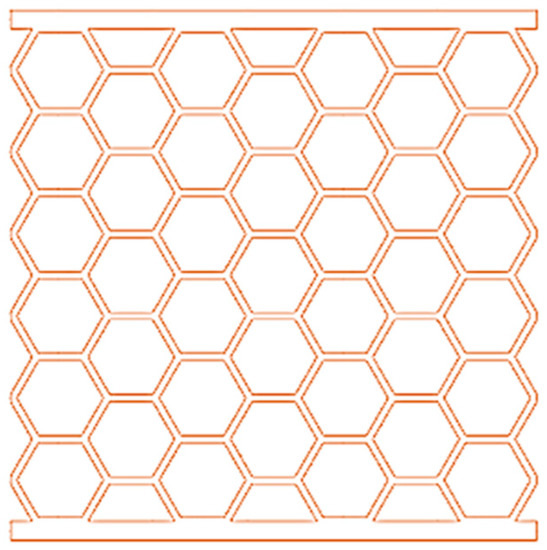
Figure 1.
Generic hexagonal structures used to develop hierarchical models. Both the hexagonal array and the top and bottom load transfer plates are shown.
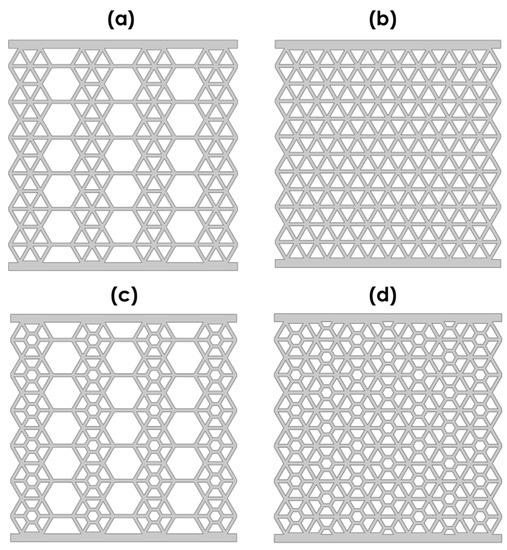
Figure 2.
(a) Triangularly reinforced pseudo-composite (TRPC) structure with pseudo-fibres in line with the axis of loading (b) a full system of triangular reinforcement within the hexagonal (pseudo-matrix) system (c.f. Figure 1), (c) scaled hexagonally reinforced pseudo-composite (SHRPC) structure with pseudo-fibres in line with the axis of loading (d) a full system of scaled hexagonal reinforcement within the original hexagonal (pseudo-matrix) system (c.f. Figure 1).
As a composite “control”, we also built a unidirectional carbon fibre reinforced plastic (CFRP) model, Figure 3, using 7 columns (4 of which represent fibre and 3 of which represent matrix). Each of the columns in this model are 8 mm wide, the complete dimensions of the composite model being 55 mm in height and 56 mm in width.
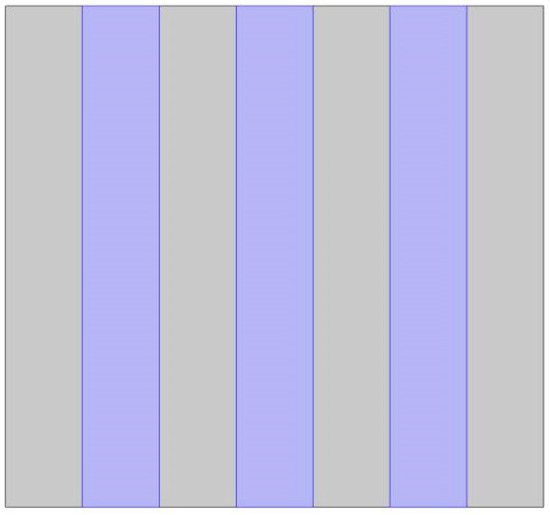
Figure 3.
Carbon fibre reinforced plastic (CFRP) model built as a control to compare pseudo-composites against.
The pseudo-composites (TRPC and SHRPC) were both modelled with the properties of Ultimaker PLA (poly-lactic acid), and the properties of the carbon fibre and the epoxy resin in the CFRP are from [27,28,29,30]; Table 1. Using the parameters in this table, we developed an elastic-perfectly plastic model and used a plane strain formulation for the simulations. All models were subjected to tensile and compressive loading and simulations were conducted in COMSOL Multiphysics. The structures were discretised using higher order Lagrange elements. Both pseudo-composites and CFRP were modelled to comprise a 57% fibre volume fraction. A Dirichlet condition was applied to the bottom plate, and loading was applied to the top plate in the axial direction. Zero degrees of translational and rotational freedom was other applied to the plate in the off-axis (orthogonal to loading axis) directions.

Table 1.
Properties input into the TRPC, SHRPC, and CFRP models.
3. Results
3.1. Tensile Properties of TRPC, SHRPC and CFRP
The tensile behaviour of TRPC, SHRPC, and CFRP can be observed through stress-strain plots provided in Figure 4, Figure 5 and Figure 6, respectively. The curves of CFRP are not dissimilar to those of unidirectional composites in tension using high strength carbon fibres [31]. Both TRPC and SHRPC mimic the composite behaviour of CFRP, as these pseudo-composites exhibit shared properties of both the pseudo-fibres and the pseudo-matrix. Importantly, both TRPC and SHRPC, similarly to CFRP, exhibit the four stages of behaviour typical to unidirectional composites. The first stage (ending at the tip of yellow linear line in each figure) is where elastic deformation occurs in both the fibre and matrix (or pseudo-fibre and pseudo-matrix). The second stage (ending at the tip of the blue line in each figure) is where elastic deformation continues in the fibre (or pseudo-fibre) while the matrix (or pseudo-matrix) deforms plastically. The third stage (ending at the tip of the green line in each figure) is mechanical behaviour that occurs through plastic deformation in both the fibre (or pseudo-fibre) and matrix (or pseudo-matrix). The final fourth stage is composite failure after fibre (or pseudo-fibre) fracture. Each of these stages are obvious in both the TRPC and SHRPC curves, and as such we demonstrate here that cellular solids, such as honeycombs, can be designed to mimic the behaviour of unidirectional composites through the judicious incorporation of structural hierarchy. The shared properties of individual components in TRPC and SHRPC, as well as for CFRP, are provided in Table 2.
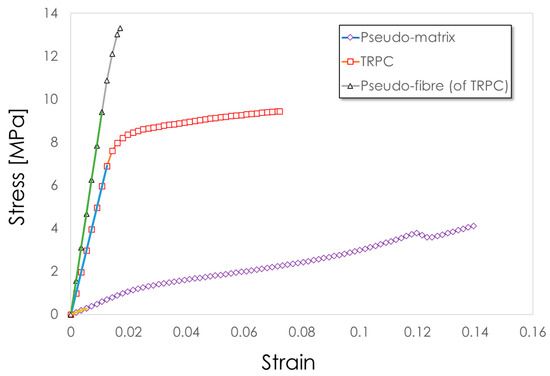
Figure 4.
Engineering stress-strain plots for TRPC in tension, pseudo-matrix in tension, and TRPC pseudo-fibre in tension.
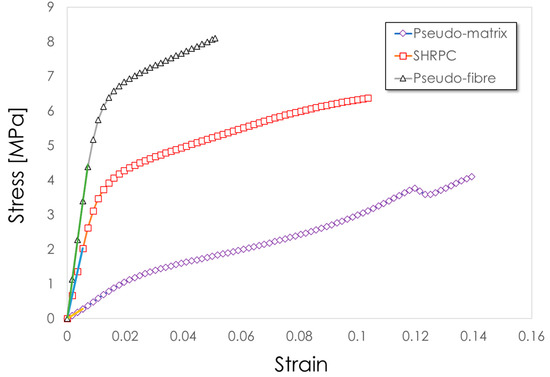
Figure 5.
Engineering stress-strain plots for SHRPC in tension, pseudo-matrix in tension, and SHRPC pseudo-fibre in tension.

Figure 6.
Engineering stress-strain plots for CFRP in tension, epoxy-matrix in tension, and carbon fibre in tension.

Table 2.
Properties of individual components making up TRPC, SHRPC, and CFRP, and of the final composite/pseudo-composites.
The rule of mixtures (RoM), Equation (1), is a common and generally accurate model for predicting the elastic modulus of unidirectional fibre reinforced composites, Ec. Here we use the model to predict the elastic modulus of the unidirectional pseudo-composites developed herein, TRPC and SHRPC, and compare these against predictions for CFRP. In this model, E is the elastic modulus and V is the volume fraction, of fibre, f, and matrix, m, materials. Table 3 provides comparisons of the RoM predicted elastic modulus against the elastic modulus determined through the finite element simulations. The RoM and simulated predicted moduli are in good agreement for both TRPC and SHRPC, and for CFRP.

Table 3.
Comparison of RoM predicted elastic modulus against simulation predicted elastic modulus for TRPC, SHRPC, and CFRP.
To assess the mechanical effectiveness of the composite as a two phase system, we compare the stress of the composite (or pseudo-composite) against the stress of the fibre (or pseudo-fibre) at the same strain level within the elastic range of linear proportonality using a fibre contribution coefficient, , Equation (2). The is a percentage measure of stress relative to the stiffest component of the composite, the fibre. A higher value indicates that the composite is more effectively designed if the design criterion is to maximise stiffness. Figure 7 shows that both TRPC and SHRPC have more effective designs for stiffness improvement.
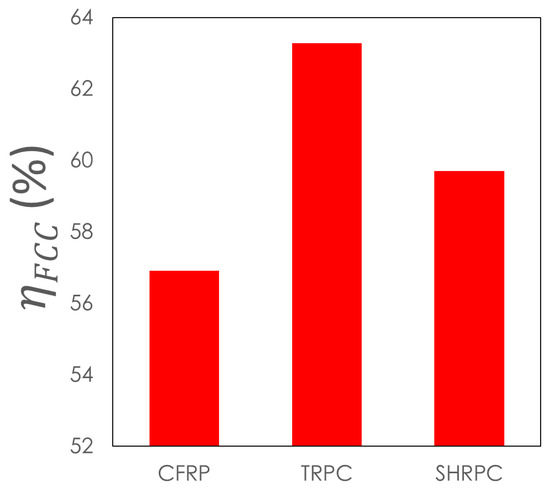
Figure 7.
plotted for each of the composites, TRPC, SHRPC, and CFRP.
3.2. Comparison of TRPC and SHRPC Mechanical Properties
Compressive simulations were conducted on the same structures to compare the compressive properties of TRPC and SHRPC against their tensile properties. The compressive behaviour of TRPC and SHRPC can be observed from the stress-strain plots provided in Figure 8 and Figure 9. The pseudo-fibres exhibit considerably greater ductility in compression than they do in tension, as well as a significantly higher capacity for energy absorption. This is most likely to be because in compression, structural elements within the honeycomb hierarchies are supported by adjacent elements in the structure, enabling greater load carrying. The Young’s modulus and maximum strain properties for each of the pseudo-composites is also provided in Table 4. While the stiffness properties are similar for individual pseudo-composites in tension and compression, the strain to failure is three-fold higher in TRPC in tension than it is in compression, and 1.5 fold higher in SHRPC in tension than it is in compression.
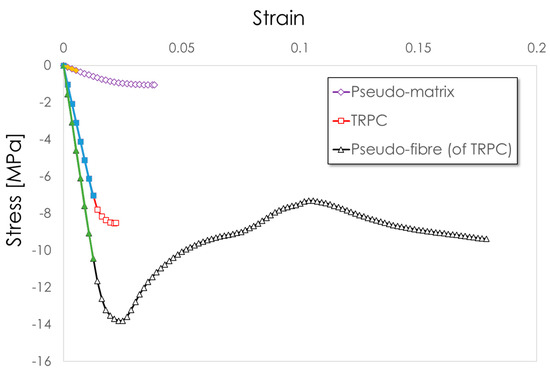
Figure 8.
Engineering stress-strain plots for TRPC in compression, pseudo-matrix in compression, and TRPC pseudo-fibre in compression.
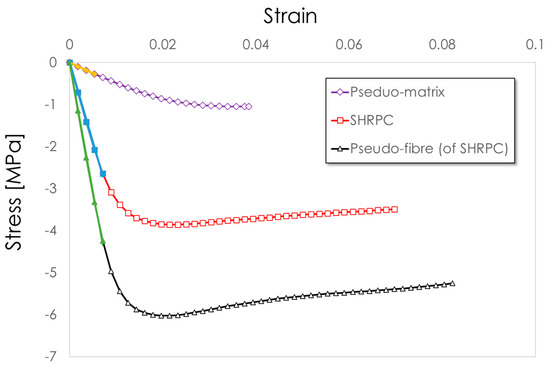
Figure 9.
Engineering stress-strain plots for SHRPC in compression, pseudo-matrix in compression, and SHRPC pseudo-fibre in compression.

Table 4.
Comparison of Young’s modulus and maximum strain values for TRPC and SHRPC in tension and compression.
4. Discussion
The judicious placement of structural hierarchy within a honeycomb structure to form pseudo-fibres has been shown to not only improve the mechanical properties of the honeycomb in both tension and compression, but to also mimic the behaviour of a two-phase unidirectional composite, such as CFRP. This is clear since the pseudo-composites researched herein (TRPC and SHRPC) clearly show the four stages of composite mechanical behaviour for a unidirectional composite in. Here, the first stage involves elastic deformation of both the pseudo-fibre and pseudo-matrix, the second stage see a continuation of elastic deformation in the pseudo-fibre, but plastic deformation in the pseudo-matrix, the third phase recognises plastic deformation in all components of the pseudo-composite and the fourth phase sees the pseudo-composite fail after pseudo-fibre failure. In compression, pseudo-fibres are noted to absorb more mechanical energy than in tension, and this is likely to be due to additional support in compression coming from connected structural elements within the hierarchy. Though the density of the two pseudo composites is the same, the Young’s modulus of TRPC is much higher than that of SHRPC, indicating that the triangular hierarchy is a more effective geometrical design than the scaled hexagonal hierarchy (c.f. Figure 2). The specific stiffness of TRPC and SHRPC is 1.13 and 0.77 MNm/kg, respectively, which is in the upper range for non-porous polymers [29], the higher range for engineering foams, and the mid-range for octet and octahedral lattice mechanical metamaterials [32]. The fracture strain of TRPC is lower than that of SHRPC, the former being 7.2%, and the latter 10.4%. The elastic modulus of both pseudo-composites in tension can be predicted using the (Voigt model) rules of mixture, which is ordinarily a model for predicting the elastic modulus of fibre reinforced composites in tension. Moreover, though the TRPC, SHRPC, and CFRP models were constructed to be of the same fibre volume fraction (57%), in the elastic range, the fibre contribution coefficient of both pseudo composites are higher than that of the CFRP, TRPC being superior to SHRPC, indicating the pseudo-composites are geometrically superior design for the maximisation of stiffness. This noted, the strain to failure of pseudo-composites, being essentially hollow and deformation structures, is high compared to CFRP. Pseudo-composites have the combined characteristics of being stiffer than in-plane honeycombs, of still high deformability, and are lightweight enough to be on the higher end of the specific modulus properties of non-porous polymers.
5. Conclusions
In this paper, we numerically compare pseudo-composites using honeycomb cells as a basis for hierarchical metamaterial design. We find that, using PLA as a base material, SHRPC are superior in mechanical performance to TRPC, though neither pseudo-composite is superior to CFRP when factoring in the combined effects of stiffness and weight. Nevertheless, both SHRPC and TRPC exhibit pseudo-fibre contribution coefficients that are superior to the fibre contribution coefficient of CFRP, suggesting therefore, that pseudo-composites have exceptional and efficient geometrical designs.
Author Contributions
Conceptualization, P.A.; methodology, Z.Y.; validation, Z.Y.; formal analysis, Z.Y. and P.A.; investigation, Z.Y. and P.A.; data curation, Z.Y.; writing—original draft preparation, Z.Y. and P.A.; writing—review and editing, P.A.; visualization, Z.Y. and P.A.; supervision, P.A.; project administration, P.A. All authors have read and agreed to the published version of the manuscript.
Funding
This research received no external funding.
Institutional Review Board Statement
Not applicable.
Informed Consent Statement
Not applicable.
Data Availability Statement
The data presented in this study are available on request from the corresponding author.
Conflicts of Interest
The authors declare no conflict of interest.
References
- Bertoldi, K.; Vitelli, V.; Christensen, J.; van Hecke, M. Flexible mechanical metamaterials. Nat. Rev. 2017, 2, 1–11. [Google Scholar]
- Yu, X.; Zhou, J.; Liang, H.; Jiang, A.; Wu, L. Mechanical metamaterials associated with stiffness, rigidity and compressibility: A brief review. Prog. Mater. Sci. 2018, 94, 114–173. [Google Scholar] [CrossRef]
- Zheludev, N.I. The road ahead for metamaterials. Science 2010, 328, 582–583. [Google Scholar] [CrossRef] [PubMed]
- Christensen, J.; Kadic, M.; Kraft, O.; Wegener, M. Vibrant times for mechanical meta-materials. MRS Commun. 2015, 5, 453–462. [Google Scholar] [CrossRef]
- Evans, K.E.; Alderson, A. Auxetic materials: Functional materials and structures from lateral thinking. Adv. Mater. 2000, 12, 617–628. [Google Scholar] [CrossRef]
- Gatt, R.; Grima, J.N. Negative compressibility. Physica Status Solidi (RRL) 2008, 2, 236–238. [Google Scholar] [CrossRef]
- Nicolaou, Z.G.; Motter, A.E. Mechanical metamaterials with negative compressibility transitions. Nat. Mater. 2012, 11, 608–613. [Google Scholar] [CrossRef]
- Kadic, M.; Buckmann, T.; Stenger, N.; Thiel, M.; Wegener, M. On the practicability of pentamode mechanical metamaterials. Appl. Phys. Lett. 2012, 100, 191901. [Google Scholar] [CrossRef]
- Wyart, M.; Liang, H.; Kabla, A.; Mahadevan, L. Elasticity of floppy and stiff random networks. Phys. Rev. Lett. 2008, 101, 215501. [Google Scholar] [CrossRef]
- Paulose, J.; Chen, B.G.; Vitelli, V. Topological modes bound to dislocations in mechanical metamaterials. Nat. Phys. 2015, 11, 153–156. [Google Scholar] [CrossRef]
- Davami, K.; Zhao, L.; Lu, E.; Cortes, J.; Lin, C.; Lilley, D.E.; Purohit, P.K.; Bargatin, I. Ultralight shape-recovering plate mechanical metamaterials. Nat. Commun. 2015, 6, 1–7. [Google Scholar] [CrossRef] [PubMed]
- Malek, S.; Raney, J.R.; Lewis, J.A.; Gibson, L.J. Lightweight 3D cellular composites inspired by balsa. Bioinsp. Biomim. 2017, 12, 026014. [Google Scholar] [CrossRef] [PubMed]
- Avalle, M.; Belingardi, G.; Ibba, A. Mechanical models of cellular solids: Parameters identification from experimental tests. Int. J. Impact Eng. 2007, 34, 3–27. [Google Scholar] [CrossRef]
- Taylor, C.M.; Smith, C.W.; Miller, W.; Evans, K. The effects of hierarchy on the in-plane elastic properties of honeycombs. Int. J. Solid Struct. 2011, 48, 1330–1339. [Google Scholar] [CrossRef]
- Gibson, L.J.; Ashby, M.F.; Schajer, G.; Robertson, C. The mechanics of two-dimensional cellular materials. Proc. Royal. Soc. Lond. A 1982, 382, 25–42. [Google Scholar]
- Gibson, L.; Ashby, M.; Zhang, J.; Triantafillou, T. Failure surfaces for cellular materials under multiaxial loads modelling. Int. J. Mech. Sci. 1989, 31, 635–663. [Google Scholar] [CrossRef]
- Wilson, S. A new face of aerospace honeycomb. Mater. Des. 1990, 11, 323–326. [Google Scholar] [CrossRef]
- Zhang, Q.; Yang, X.; Li, P.; Huang, G.; Feng, S.; Shen, C.; Han, B.; Zhang, X.; Jin, F.; Xu, F. Bioinspired engineering of honeycomb structure using nature to inspire human innovation. Prog. Mater. Sci. 2015, 74, 332–400. [Google Scholar] [CrossRef]
- Ajdari, A.; Jahromi, B.H.; Papadopoulos, J.; Nayeb-Hashemi, H.; Vaziri, A. Hierarchical honeycombs with tailorable properties. Int. J. Solid Struct. 2012, 49, 1413–1419. [Google Scholar] [CrossRef]
- Wegst, U.G.; Bai, H.; Saiz, E.; Tomsia, A.P.; Ritchie, R.O. Bioinspired structural materials. Nat. Mater. 2015, 14, 23–36. [Google Scholar] [CrossRef]
- Zhang, D.; Fei, Q.; Liu, J.; Jiang, D.; Li, Y. Crushing of vertex-based hierarchical honeycombs with triangular substructures. Thin-Walled Struct. 2020, 146, 106436. [Google Scholar] [CrossRef]
- He, Q.; Feng, J.; Honggen, Z. A numerical study on the in-plane dynamic crushing of self-similar hierarchical honeycombs. Mech. Mater. 2019, 138, 103151. [Google Scholar] [CrossRef]
- Li, S.; Liu, Z.; Shim, V.P.W.; Guo, Y.; Sun, Z.; Li, X.; Wang, Z. In-plane compression of 3D-printed self-similar hierarchical honeycombs—Static and dynamic analysis. Thin-Walled Struct. 2020, 157, 106990. [Google Scholar] [CrossRef]
- Tao, Y.; Li, W.; Wai, K.; Duan, S.; Wen, W.; Chen, L.; Pei, Y.; Fang, D. Mechanical properties and energy absorption of 3D printed square hierarchical honeycombs under in-plane axial compression. Compos. Part B 2019, 176, 107219. [Google Scholar] [CrossRef]
- Wang, B.; Ding, Q.; Sun, Y.; Yu, S.; Ren, F.; Cao, X.; Du, Y. Enhanced tunable fracture properties of the high stiffness hierarchical honeycombs with stochastic Voronoi substructures. Results Phys. 2020, 12, 1190–1196. [Google Scholar] [CrossRef]
- Ilankeeran, P.K.; Mohite, P.M.; Kamle, S. Axial tensile testing of single fibres. Mod. Mech. Eng. 2012, 2, 151–156. [Google Scholar] [CrossRef]
- Wang, Z.; Liang, Z.; Wang, B.; Zhang, C.; Kramer, L. Processing and property investigation of single-walled carbon nanotube (SWNT) buckypaper/epoxy resin matrix nanocomposites. Compos. Part A 2004, 35, 1225–1232. [Google Scholar] [CrossRef]
- Chung, D.D.L. Carbon Fiber Composites, 1st ed.; Elsevier (Imprint: Butterworth-Heinemann): Oxford, UK, 2012. [Google Scholar]
- Shirasu, K.; Nakamura, A.; Yamamoto, G.; Ogasawara, T.; Shimamura, Y.; Inoue, Y.; Hashida, T. Potential use of CNTS for production of zero thermal expansion coefficient composite materials: An experimental evaluation of axial thermal expansion coefficient of CNTS using a combination of thermal expansion and uniaxial tensile tests. Compos. Part A 2017, 95, 152–160. [Google Scholar] [CrossRef]
- Mouritz, P. Introduction to Aerospace Materials; Elsevier (Imprint: Woodhead Publishing): Cambridge, UK, 2012. [Google Scholar]
- Injeti, S.S.; Daraio, C.; Bhattachrya, K. Metamaterials with engineered failure load and stiffness. Proc. Natl. Acad. Sci. USA 2019, 116, 23960–23965. [Google Scholar] [CrossRef]
- Almadan, Y.; Dirikgil, T. Experimental investigation of the flexural strengthening of fixed-supported RC beams. Int. J. Civil. Eng. 2020, 18, 1229–1246. [Google Scholar] [CrossRef]
Publisher’s Note: MDPI stays neutral with regard to jurisdictional claims in published maps and institutional affiliations. |
© 2021 by the authors. Licensee MDPI, Basel, Switzerland. This article is an open access article distributed under the terms and conditions of the Creative Commons Attribution (CC BY) license (http://creativecommons.org/licenses/by/4.0/).